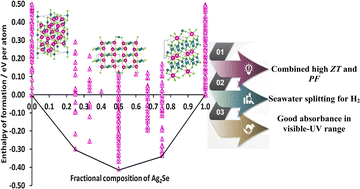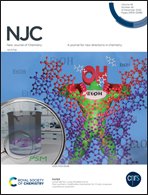Prediction of stable silver selenide-based energy materials sustained by rubidium selenide alloying†
Abstract
Silver selenide (Ag2Se) is a ductile material with a low lattice thermal conductivity that can be a valuable substitute for both PbSe and Bi2Se3 for Pb toxicity free and Bi scarcity. However, its narrow band gap in bulk phase and low dopability for its monolayer form, limit the potential of Ag2Se as a practical energy converter. Whereas earlier halogenated Ag2Se studies show a greatly elevated Seebeck coefficient due to the broadened band gap, the approach yielded little improvement for the dopability of its monolayer. Motivated by the positive effects of lighter alkalis on optical and thermoelectric responses of semiconductors, the thermal stability, thermoelectric and luminescence properties of bulk and two-dimensional (2D) RbxAg1−xSe phases were comprehensively investigated using a global evolutionary algorithm and density functional theory (DFT), followed by semiclassical Boltzmann transport formalism. The electronic structure and chemical bonding (COHP) results show that these structures are thermodynamically and mechanically stable for the entire Rb composition range, with a band gap that increases monotonically with Rb content, and is in the range of 1.41–2.75 eV within the Heyd–Scuseria–Ernzerhof (HSE06) hybrid functional, which demonstrates the possibility of their laboratory synthesis. Satisfactory optical absorption in the order of 104–105 cm−1 is seen spanning the visible and ultraviolet regions. The fundamentally low lattice thermal conductivity below 1.0 W m−1 K−1 throughout the temperature range studied is attributed to the complex structure and relatively low sound velocity. Under optimal hole concentration, their thermoelectric figure of merit (ZT) and power factor (PF) can reach magnitudes of 0.6–1.0 and 0.68–24.2 mW m−1 K−2, respectively, between 300 and 1000 K. The monolayer Rb2Ag2Se2 in particular stands out with its high ZT and improved dopability when compared to those of the monolayer Ag2Se. Comparison of the band edge positions with the redox potential of water indicates that the bulk Rb2Ag2Se2 phase exhibits satisfactory photocatalytic activity in seawater splitting. This work validates that the grinding together of stoichiometric quantities of Rb2Se and Ag2Se is an effective alternative for improving the dopability of monolayer Ag2Se and engineering RbxAg1−xSe, with focused characteristics to suit environmental conditions.



 Please wait while we load your content...
Please wait while we load your content...